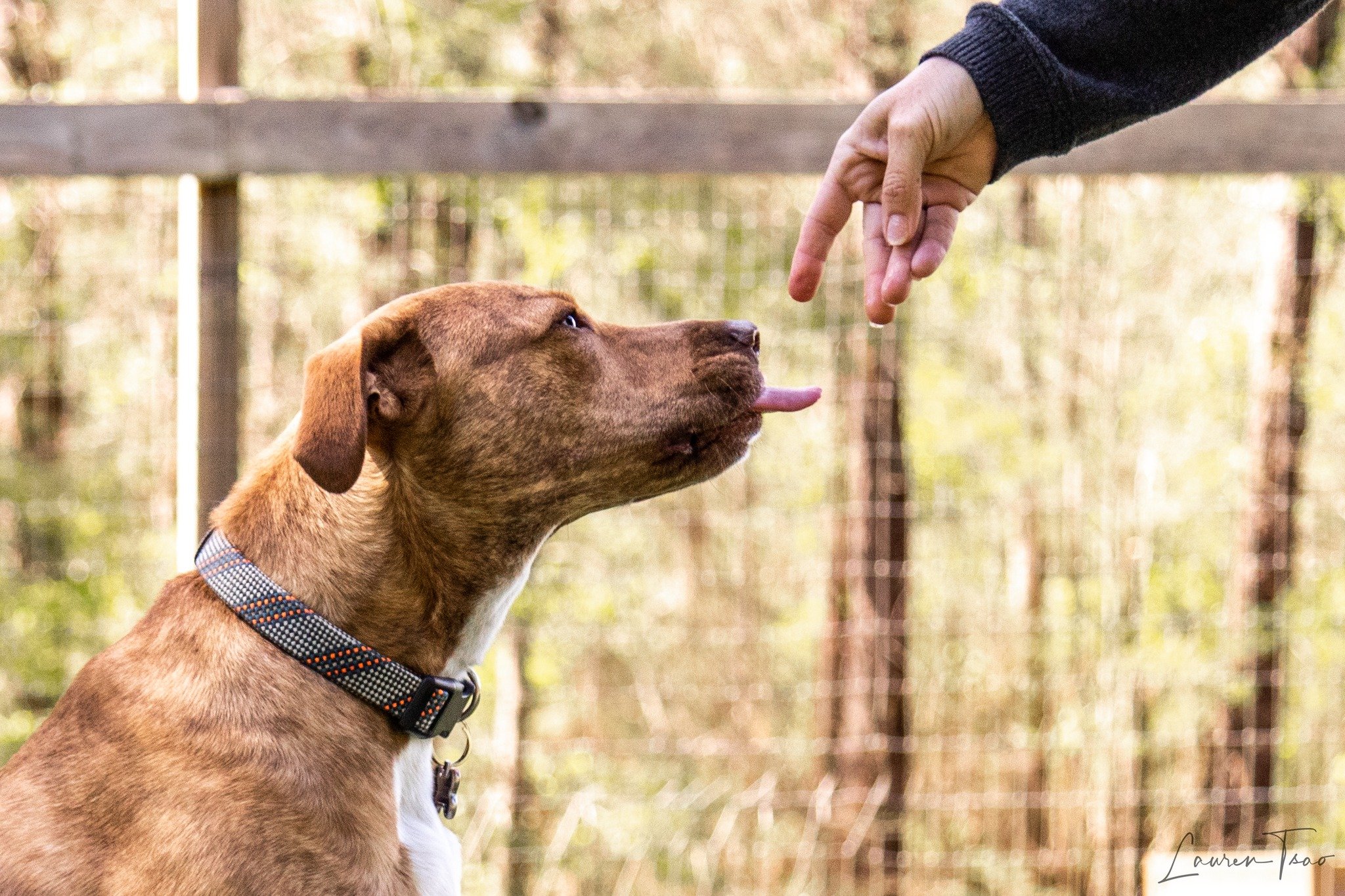
Dog Training & Behavior Tips

You Hired a Professional Dog Trainer. Now Let Them Do Their Job!
When you hire a dog trainer or behavior consultant, you’re not just paying for their time, you’re investing in their expertise, methods, and carefully developed process. Yet, many students unknowingly undermine this process by asking their trainer to work outside their area of expertise, change their methods, or skip important steps.
This blog post explores why it’s essential to trust your trainer’s approach, whether it’s using positive reinforcement instead of training collars or following a structured behavior assessment.

"He Seems Fine to Me!" Why Active Dogs Can Still Have Medical Issues
Does your dog’s energy and playfulness mean they’re perfectly healthy? Not always. Dogs are masters at masking discomfort, often staying active, even increasing their activity, to distract themselves from pain. This post explores why your dog’s boundless energy might not tell the full story, the subtle signs of underlying issues you might be missing, and why addressing their health first is key to effective training.

Beretta’s Story: The Dog Who Changed Everything
This blog post tells the story of Beretta, a rescue dog whose challenging behaviors initially appeared to be rooted in severe anxiety and fear. Over time, it became clear that her struggles went deeper, as her reactions to the environment and difficulty with training hinted at an underlying issue. After years of managing her behavior through training, medication, and environmental changes, a veterinary specialist confirmed that Beretta was…

Your Dog Deserves the Best: Choosing the Right Vet and Knowing When to Switch
In this blog, we discuss the importance of selecting the right veterinarian and knowing when to seek a second opinion to ensure your dog's health and well-being. I share the story of Oakley, my dog diagnosed with discospondylitis after persistent advocacy and seeking a second opinion, highlighting the value of trusting your instincts as a dog owner. I offer practical steps for choosing a vet, including assessing their communication style, expertise, and ability to address your dog’s unique needs.

Understanding the Prevalence of Behavior Problems in Dogs – Insights from the Dog Aging Project
The Dog Aging Project (DAP) provides groundbreaking insights into the prevalence and scope of behavioral challenges in dogs. Analyzing data from over 43,000 dogs, this study found that nearly all dogs (99.12%) exhibit moderate-to-serious behavioral issues, ranging from aggression and anxiety to separation-related behaviors and housesoiling. The blog post emphasizes the importance of early recognition and intervention to address these issues. Behavioral problems often reflect deeper emotional, physical, or environmental concerns, requiring a “big picture” approach. Through tools like behavioral assessments, tailored training plans, and collaboration with veterinarians, owners can address their dog’s needs effectively.

Behavioral Challenges in Brachycephalic Dogs: A Hidden Complexity
Brachycephalic breeds, such as French Bulldogs and Pugs, are becoming increasingly popular, with the French Bulldog recently named the most popular dog breed in the U.S. While their charming, expressive faces appeal to many, these flat-faced breeds often face unique behavioral and medical challenges rooted in their anatomy.

Behavioral Quirks or Signs of Stress? A Look Into Blanket and Flank Sucking in Dogs
The blog post explores the intriguing behavior of blanket and flank sucking in dogs, particularly in Doberman Pinschers. It explains that this behavior is often a self-soothing mechanism rooted in comfort-seeking. Studies on flank sucking in Dobermans show it may have a hereditary component and parallels certain compulsive disorders in humans. Drawing from research, the post highlights how genetic predispositions, early weaning, and stress can contribute to this behavior.

Unpacking Dog Aggression Towards People: Insights from Behavior Consultations
This blog post delves into the complexities of aggression in dogs, highlighting how stress, fear, and anxiety often underlie this behavior. Drawing on recent research, it emphasizes the importance of recognizing early stress indicators like yawning, trembling, and excessive attention-seeking as precursors to aggressive responses. The blog discusses the detrimental impact of punitive measures, which can exacerbate anxiety and escalate aggression, and instead advocates for trust-based, positive reinforcement methods.

Understanding Behavioral Challenges in Dogs with Idiopathic Epilepsy
This blog post explores how idiopathic epilepsy (IE) in dogs affects not only their physical health through seizures but also their behavior and emotional well-being. A recent study highlights that dogs with IE often exhibit heightened excitability, attention-seeking behaviors, and cognitive impairments, which can be influenced by the neurological condition and its treatments.

Dog Pain and Behavior: How to Identify the Signs and Take Action
This blog post explores a recent study published in the Journal of Veterinary Behavior, which examined how well dog owners can identify pain-related behaviors in their pets. The study revealed that many owners struggle to recognize subtle signs of discomfort, particularly in older dogs where behaviors may be mistaken for normal aging.

Why is My Dog Aggressive Towards Other Dogs?
Aggression towards other dogs is often a complex behavior influenced by a variety of factors, including fear, frustration, physical discomfort, and environmental triggers. This blog post delves into the common causes of aggression and how to recognize early warning signs.

Classical Conditioning and Your Dog: Understanding How It Shapes Behavior
This blog post explores the concept of classical conditioning and how it influences dog behavior. Classical conditioning, first studied by Ivan Pavlov, explains how dogs (and all animals) can learn to associate neutral stimuli, like sounds or objects, with meaningful outcomes, such as rewards or discomfort…

Helping Reactive Dogs: When Emotional Arousal Is Linked to Pain
This blog post explores how emotional arousal, commonly referred to as "reactivity," in dogs can often be linked to underlying pain or discomfort. Emotional arousal is characterized by heightened responses to stimuli, such as excessive barking, lunging, or hypervigilance, which can interfere with a dog’s ability to calm down…

When Thunderstorms Hurt: Understanding the Link Between Pain and Phobia in Dogs
This blog post explores the connection between discospondylitis, a painful spinal condition in dogs, and the sudden development of thunderstorm phobia in three case studies, including my own dog, Oakley. Diagnostic challenges, including the limitations of X-rays, are discussed. Treatment, involving antibiotics, pain management, and reduced activity, led to behavioral improvements in all three dogs, though recovery timelines varied.

Can Dogs with Chronic Pain Experience the “October Slide”?
This blog post explores the concept of the "October Slide" and its impact on dogs with chronic pain conditions. The "October Slide" refers to the worsening of chronic pain symptoms during colder months, often starting in October, due to environmental factors such as cooler temperatures, damp weather, and reduced daylight. These changes can lead to increased pain sensitivity, decreased activity levels, and behavioral shifts like irritability or avoidance.

Is Your Dog’s Car Anxiety a Sign of Pain?
We explore how a dog’s discomfort during car rides may not just be anxiety but a sign of physical pain or discomfort. Dogs experiencing stress during car travel often undergo subtle strain from the vehicle’s movement, needing to make constant balancing adjustments that can exacerbate any underlying pain, particularly in dogs with joint or muscular issues…

When Dog Training Isn’t Enough - a Dynamic Dog Case Study
The case study of A, a 2.5-year-old Feist mix, illustrates how persistent behavior issues often have deeper, underlying causes. Despite extensive training, A continued to struggle with aggression, pulling on walks, and inconsistent eating. A key observation of A's unusual hind-leg skipping led to further investigation. This was when a Dynamic Dog Assessment, an approach that considers the whole dog's physical health, behavior, and environment, revealed subtle discomfort signals that changed A’s life.

How Pain Can Lead to Undesirable Dog Behavior (And What You Can Do About It)
We explore the often-overlooked connection between pain and undesirable behaviors in dogs. It provides a comprehensive guide on recognizing the subtle signs of pain, such as changes in sleep patterns, mobility, and social interactions. By understanding how pain can impact a dog's behavior, owners can take proactive steps to improve their dog's well-being. The article includes practical advice on tracking symptoms, consulting with veterinarians and Dynamic Dog Practitioners, and managing pain effectively…

Desensitization and Counter-Conditioning for Aggressive Dogs
Dogs can become aggressive for a variety of reasons, whether it’s due to fear, insecurity, frustration, mistrust of strangers, or just a general lack of socialization. Whatever the reason may be, dog owners need to be aware of the signs of aggression in their dogs and how to properly (and safely) address it. One way to help an aggressive dog is through desensitization and counter-conditioning. In many cases, aggressive behaviors like lunging, barking, and growling can be decreased through a process called desensitization and counter-conditioning.
